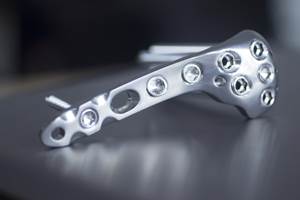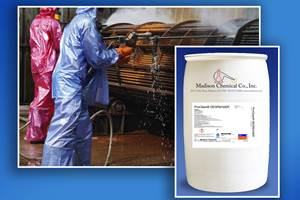Precision Cleaning: An Introduction
Many manufacturers today are coming to cleaning for the first time.
Share





Over the last several years, there has been a trend among OEMs toward making sub-tier suppliers more responsible for the cleanliness requirements of parts and assemblies.
In addition to this, the very importance of part cleanliness is growing. Many producers that might once have dismissed cleaning discover all too late that their highly engineered, closely toleranced devices can be rendered inoperable by a particle too tiny to be seen with the naked eye.
For these various reasons, engineers and quality managers who may not have considered the topic before are now giving serious attention to cleaning. For these newcomers, this article offers some basic information.
How Clean?
Parts cleaning is a broad field. It ranges from "gross" cleaning of heavy industrial components to "critical" cleaning for the space program, with a wide spectrum of options in between. Many factors determine which cleaning processes best fit a particular need.
One basic question is: Just how clean do your parts need to be, and who is going to determine this? In the event that the customer has imposed a cleanliness specification, then at least this offers a place to start—cleanliness is now a matter of compliance. But if not, then the shop will need someone experienced in selecting an appropriate cleaning process.
A job shop specializing in this field may be appropriate here. Parts sent for evaluation can be tested to determine the existing level of cleanliness (or lack thereof). After an experimental cleaning run, the part can be tested to quantify the cleanliness level that results. The functionality of this clean part can then be tested in the application. If the performance is satisfactory, then this level of cleanliness, along with the methods used to obtain it, can provide a benchmark.
Cleaning Options
The next factors to be considered are the equipment and the process, factors that will ultimately be determined by the volume and the type of contamination, along with the material and complexity of the part.
There are several options. For those hoping to perform cleaning in-house, most of these entail significant capital expense. Therefore, before going too far, it is always best to determine the nature of the contaminant to see if it can be eliminated from manufacturing. Even if it can, however, precision cleaning may still be necessary to ensure the smooth operation of a closely toleranced mechanical assembly.
Cleaning options include vapor degreasing, pressure washing, CO2 snow and even mechanical blasting followed by a filtered rinse. These are common ways to achieve a high level of cleanliness. For removing the smallest and most tenacious particles, particularly on parts with complex geometries, another potentially effective option is ultrasonic cleaning. The frequency of this process is tailored to particular particles. (The rule is: the finer the particles, the higher the frequency.) However, lower frequencies can shatter delicate material, or (even worse) can introduce microcracks that escape detection, so this option isn't universally suitable.
Attention After Cleaning
After cleaning, don't underestimate the importance of the remaining processes. Rinsing, drying, preserving and packaging all present their own nuances. If you need spot-free parts, for example, you will need a deionized water system.
Drying of the parts can be the most time consuming step of all. Options range from blowing down with shop air to vacuum bake-out ovens. One particularly convenient and cost-effective device is a portable dryer consisting of a small electric turbine producing heat via mechanical friction, with the intake filtered to three microns to ensure purity at the output end. The user simply blows the parts dry without shop air, and therefore without having to worry about recontamination resulting from a faulty oil trap on the shop air compressor.
What comes next is quickly becoming the prominent factor in much of the cleaning industry, and that's the quantitative verification of the cleaning process. There are two commonly accepted methods of obtaining cleanliness samples for this purpose. One involves spraying the test part with a sub-micron-filtered solvent from a pressurized spray can, collecting the effluent and running it through a vacuum filter funnel that deposits the debris onto a special test filter. The second method is to sonicate the parts in solvent, remove the parts from the bath and rinse them with additional solvent, collecting and filtering the effluent as in method one. The most commonly called-out particle analysis criteria are count, maximum particle size and weight—and it's not uncommon to see a combination of two or even all three.
Environmental Concerns
I've made environmental issues the last topic, but perhaps this should be the first concern. It would be a disaster to develop a process and have it installed, only to find out that the municipality won't issue a permit to run it. Questions to consider here include: What will you be removing from the parts, and what are you using to remove it? Do you need local, state or federal permits to store, use and dispose of your chemistry? What will you do with your spent cleaning solutions and rinse water, both of which will contain the contaminants removed from the parts? Will one or both of them be reportable as "hazardous" in your waste stream? (It can be cost-effective to purchase an evaporator, by the way—which will greatly reduce the volume of wash and rinse waters.) And what about the effect of this chemistry on your employees—is it safe? What are the exposure limits? Some alkaline cleaners are highly caustic and can burn the skin and irritate the respiratory system with very limited exposure. I strongly advise investigating this area fully before committing too much time or money.
About the author: Charles Osborn is business manager of the precision cleaning division of PTI Industries (Enfield, Connecticut), a company that provides cleaning and testing services.
Related Content
Kyzen Solvents Provide Ease of Cleaning for Medical Parts
The Metalnox line of solvent products are designed to improve reliability and increase the ease of cleaning in vacuum and vapor degreasing processes.
Read MoreParts Cleaning Trends, Equipment and Solvents at IMTS 2024
Trends in solvent replacement and environmentally friendly efforts are featured in this year’s parts cleaning booths.
Read MoreMiraclean Ultrasonic Part Cleaning System Enables Automated Operation
IMTS 2024: Miraclean’s plug-and-play parts cleaning system includes a load-unload and an ultrasonic clean, an ultrasonic rinse, a static rinse and a re-circulating hot air dry.
Read MoreMadison Chemical Degreaser Easily Removes Machining Oil
ProClean Degreaser quickly and completely removes oil and grease with its superior wetting and penetrating properties.
Read MoreRead Next
Registration Now Open for the Precision Machining Technology Show (PMTS) 2025
The precision machining industry’s premier event returns to Cleveland, OH, April 1-3.
Read MoreSetting Up the Building Blocks for a Digital Factory
Woodward Inc. spent over a year developing an API to connect machines to its digital factory. Caron Engineering’s MiConnect has cut most of this process while also granting the shop greater access to machine information.
Read MoreBuilding Out a Foundation for Student Machinists
Autodesk and Haas have teamed up to produce an introductory course for students that covers the basics of CAD, CAM and CNC while providing them with a portfolio part.
Read More





























